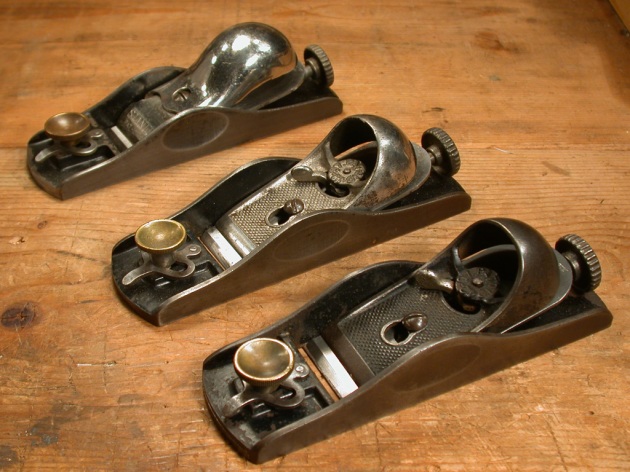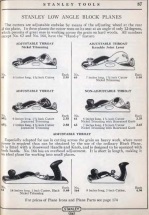An Inexplicable Affinity for Low Angle Block Planes
June 27, 2012 6 Comments
There’s something inexplicably sexy about low angle block planes. Arguably the more versatile of all the block planes, low angle blocks were not historically the best-selling models in the lineup. Stanley, and their counterparts at Millers Falls and Sargent (among others), were relatively conservative in their low angle offerings, at least compared to the standard angle variants they made.
If you include their more exotic models, Stanley produced a total of just 8 different variations of low angle block planes:
| Model | Length | Width | Adj. Throat | Trim |
| No. 60 | 6 inches | 1-3/8″ iron | Yes | Nickel |
| No. 60 1/2 | 6 inches | 1-3/8″ iron | Yes | Japanned |
| No. 61 | 6 inches | 1-3/8″ iron | No | Nickel |
| No. 62 | 14 inches | 2″ iron | Yes | Nickel |
| No. 63 | 7 inches | 1-5/8″ iron | No | Nickel |
| No. 64 | 12-1/2 inches | 2″ iron | No | Nickel |
| No. 65 | 7 inches | 1-5/8″ iron | Yes | Nickel |
| No. 65 1/2 | 7 inches | 1-5/8″ iron | Yes | Japanned |
Setting aside the extraordinary no. 62 ‘low angle jack’ and its oddball (and extremely rare ) short-lived brother, the no. 64, which were only called block planes due the bevel-up orientation of their irons, we’re left with six contenders. Let’s review them in order…
The no. 60 & no. 60-1/2
The 60 series of Stanley planes includes the no. 60 and the no. 60-1/2. Both planes are identical in every way other than their trim. The no. 60, introduced in 1898, featured nickel-plated trim, while the no. 60-1/2, introduced in 1902, had japanned trim. Just to avoid any possible confusion, the beds were japanned on all Stanley planes. Trim refers to the lever caps, which came nickel-plated on the no. 60 and japanned on the no. 60-1/2. Likewise, the knobs and adjustment wheels were nickel-plated on both the no. 60 and the no. 60-1/2. [1]
The ‘Type 1’ version of the no. 60, originally introduced with a rosewood front knob and no adjustable throat plate, was updated in 1902 with a brass front knob and an adjustable throat plate with an upturned eccentric adjusting lever. Iron width on these planes is stated to be 1-1/2 inches prior to 1913, but I’ve never seen an example of this.[2] Every one of this vintage that I’ve owned has featured a 1-3/8 inch iron with the J trademark stamp, which is correct for the period and dates from prior to 1909 on block planes (as far as I can tell).
These are my favorites of the low angle block planes. I prefer their smaller 6 inch length for trimming end grain, an application at which low angle blocks excel. Additionally, since their beds are set at 12 degrees and their irons positioned bevel up, you have the flexibility of changing the bevel angle to affect a change in the angle of cut. With its bevel sharpened at the standard 25 degrees, you get a 37 degree angle of cut (12 + 25 = 37). However, you could reasonably sharpen the bevel at 33 degrees and get a 45 degree cut, the same as a standard angle plane. With two irons sharpened at different angles, you could conceivably get by with just one block plane for both standard and low angle cuts.
A note of caution… low angle planes are a little more fragile than standard angle planes for two reasons. First, the angle of the bed is much sharper, making the leading edge (back edge of the mouth) more prone to chipping and cracking, so go easy on them when planing. Second, don’t tighten the lever cap too much. It puts a strain on the threads of the depth adjustment mechanism at the rear when you adjust the iron depth. If it’s too tight, those threads can strip.
The no. 61 & no. 63
Introduced in 1914 and 1911 respectively, it appears that neither the no. 61 nor the larger no. 63 were particularly successful for Stanley. Very few folks were tempted to purchase a low angle plane without an adjustable throat, especially when that feature could be had for just a few pennies more. Subsequently, their limited popularity constricted demand and production, and so they are fairly hard to find today. While collectible due to their scarcity, users looking for a functional low angle block are far better off sourcing a no. 60 or 65 in good condition.
Ironically, these planes are virtually identical to the very first type no. 60 and no. 65, both of which were introduced in 1898 with a similar wooden knob and lacking an adjustable throat. Why then, less than 10 years later, Stanley thought reintroducing this handicapped design under the model nos. 61 and 63 was a good idea is anyone’s guess. Regardless, both the no. 61 and no. 63 are easily distinguished from the Type 1 no. 60 and 65 since their model numbers were cast in relief at the rear of the bed just below the depth adjustment knob. Manufactured for less than 25 years, both planes were discontinued in 1935.
The no. 65 & no. 65-1/2
The 65 series includes the highly regarded no. 65 and less common no. 65-1/2. Measuring about 7 inches long with 1-5/8″ irons, these planes are the bigger brothers to the 60 series of low angle blocks.
Like the 60 series, the lineage of the no. 65 series is equally convoluted. Introduced in 1898, the no. 65 was first offered with a nickel-plated hooded style lever cap, wooden front knob, and non-adjustable throat. The first major change happened in about 1905 when the wooden knob was replaced with the same brass knob used on all the other blocks, and an adjustable throat was added. The third major change took place around 1913 when the hooded lever cap was replaced with Bodmer and Burdick’s newly designed knuckle joint lever cap, the same that was updated on the no. 18 and no. 19 standard angle planes. 50 years later, in 1964, the lever cap was changed back to the hooded type found on the no. 9-1/2, before the plane was discontinued altogether in 1969.
Considered one of the best block planes Stanley ever made, the no. 65 is sometimes referred to as the ‘Cadillac’ of block planes by vintage tool enthusiasts today. While I prefer the smaller no. 60, the no. 65 is indeed an exceptionally well designed plane and a pleasure to use, using the same care considerations noted above for all the low angle blocks.
The no. 65-1/2 version is a bit of an oddball, at least in my opinion, in that it retained the original japanned hooded style lever cap throughout its entire lifespan. While I don’t see nearly as many of them as I do the more popular no. 65, they were certainly made for a very long time (1902-1950).
There appears to be some inconsistencies in some very reputable published references, which imply that the 65-1/2 was offered with nickel trim. I don’t believe this was ever the case. Stanley catalogs from back in the day all list the no. 65 as having nickel trim and the no. 65-1/2 with japanned trim. It’s a little hard to see, but click on the image above to view a page taken from Stanley’s 1935 catalog. Center left on the page lists the no. 60-1/2 and no. 65-1/2 together, both with japanned trim.
_____________________________
1. Depending on the reference, it appears that Stanley might have used both polished brass and nickel-plated knobs and adjustment wheels at various times. While it is very common for the nickel plating on these parts to be well worn, I’ve seen enough examples both with traces of nickel and others with no trace whatsoever that lead me to believe that Stanley wasn’t always consistent across models.
2. Walter, John, Stanley Tools: Guide to Identity and Value, 1996.
***
Tools shown in the photos were returned to functional condition by Virginia Toolworks using museum quality archival preservation techniques. Sharpened and tuned for use, every tool is fully tested and adjusted until perfect.




I was researching 65 1/2 block planes, and read your page about how they were only offered with a japanned hooded lever cap. Take a look at http://www.Patented-Antiques.com. Click on Stanley Planes, then Low Angle & Other block planes. See the photo of the second plane on that list, a 65 1/2 that has been sold.
LikeLike
Yep, the plane in that photo is a very nice #65 dating from about 1913 to 1918. It’s not a #65-1/2. The box dates from 1918 to 1932 and was undoubtedly paired with the plane at some later time. There is a lot of confusion about the #65 and #65-1/2, with plenty of well intended but incorrect or conflicting information published. I’m drawing my conclusions directly from Stanley catalogs ranging from the late 1800s to 1950s. In all of these catalogs the “1/2” version of each of Stanley’s standard angle and low angle block planes featured a japanned lever cap. This is further substantiated in the replacement parts section of some of these catalogs as well. I can tell you with 100% confidence that the #65-1/2 planes had japanned lever caps.
LikeLike
The table at the beginning shows:
No. 60 6 inches 1-3/8″ iron
No. 60 1/2 6 inches 1-5/8″ iron
The paragraph that follows states Both planes are identical in every way other than their trim.
which is correct?
LikeLike
Good catch! You’re right, the chart has a typo (I just corrected it). Both the 60 and 60-1/2 have 1-3/8″ irons.
LikeLike
Pingback: Stanley Hand Wood Planer – TonyWoodsArt
Pingback: Wood Plane Numbers – woodoo